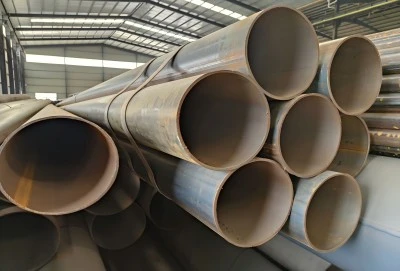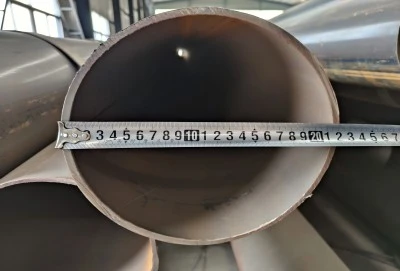Electric resistance welded (ERW) pipe has become a cornerstone in various industries, from oil and gas to construction and infrastructure. Its popularity stems from its strength, durability, and cost-effectiveness. But have you ever wondered how these essential pipes are made? Let's dive into the fascinating world of ERW pipe manufacturing, exploring each step of the process from raw material preparation to the final product.
|
|
|
Raw Material Preparation and Forming
The journey of an electric resistance welded pipe begins with high-quality steel. Manufacturers typically use hot-rolled steel coils as the primary raw material. These coils are carefully selected based on the desired specifications of the final product, including factors like chemical composition, mechanical properties, and dimensional requirements.
The first step in the manufacturing process is to uncoil the steel sheet and feed it through a series of rollers. This process, known as leveling or flattening, ensures that the steel sheet is perfectly flat and free from any residual curvature from being coiled. It's crucial for the subsequent forming steps and ultimately affects the quality of the welded seam.
Once flattened, the steel sheet moves through a series of forming rolls. These rolls gradually bend the sheet into a cylindrical shape, creating what's known as an "open seam pipe." The edges of the sheet are carefully aligned to prepare for the welding process. The precision of this forming stage is critical, as it directly impacts the quality of the weld and the overall structural integrity of the finished pipe.
Interestingly, the diameter of the pipe is determined at this stage by adjusting the forming rolls. This flexibility allows manufacturers to produce pipes of various sizes using the same production line, making ERW pipe manufacturing a versatile and efficient process.
Welding and Sizing
The heart of electric resistance welded pipe manufacturing lies in the welding process. As the name suggests, electric resistance welding is used to join the edges of the formed steel sheet. This process utilizes the principle of electrical resistance to generate heat at the edges of the steel sheet, effectively melting and fusing them together.
In ERW, high-frequency electrical current is applied to the edges of the steel through contact wheels or sliding contacts. The resistance of the steel to this current generates intense, localized heat. Simultaneously, pressure is applied to squeeze the heated edges together, creating a forge weld. This process happens continuously as the pipe moves through the production line, creating a consistent, longitudinal weld along the entire length of the pipe.
One of the key advantages of ERW is that it doesn't require any additional filler material. The weld is formed purely from the parent metal, which can result in a stronger joint compared to some other welding methods. The speed of the ERW process also contributes to its efficiency and cost-effectiveness in pipe production.
After welding, the pipe passes through sizing rolls. These rolls fine-tune the pipe's diameter and roundness, ensuring it meets the required specifications. The sizing process also helps to relieve any internal stresses that may have developed during the forming and welding stages, contributing to the overall quality and reliability of the finished product.
Quality Control and Post-processing
Quality control is a critical aspect of ERW pipe manufacturing. Throughout the production process, various checks and tests are performed to ensure the pipe meets all required standards and specifications.
One of the primary quality control measures is non-destructive testing (NDT) of the weld seam. This typically involves ultrasonic or eddy current testing, which can detect any defects or inconsistencies in the weld without damaging the pipe. These tests are often performed in real-time as the pipe is being produced, allowing for immediate corrective action if any issues are detected.
Hydrostatic testing is another crucial quality control measure. In this test, an electric resistance welded pipe is filled with water and pressurized to a level above its designed operating pressure. This test checks for any leaks or weaknesses in the pipe body or weld seam.
Post-processing steps may include heat treatment to enhance the pipe's mechanical properties or to relieve any residual stresses from the manufacturing process. The pipe may also undergo straightening to ensure it meets straightness tolerances.
Finally, the pipe is cut to the required length, and end finishing operations such as beveling or threading may be performed depending on the pipe's intended application. The finished pipes are then inspected, marked according to the relevant standards, and prepared for shipping.
Longma Group
The manufacturing of electric resistance welded pipe is a complex yet efficient process that combines advanced technology with precise engineering. From the careful preparation of raw materials to the high-tech welding process and rigorous quality control measures, every step is designed to produce pipes that meet the highest standards of quality and performance.
Longma Group Electric Resistance Welded Steel Pipe is manufactured to meet a range of industry standards, ensuring quality and reliability. Adhering to specifications from API 5L, ASTM A53, ASTM A500, ASTM A252, and ASTM A795, these pipes are designed for various applications in the oil, gas, and construction industries, providing a robust solution for both structural and pressure piping needs. If you are choosing your electric resistance welded pipe manufacturers, welcome to contact LONGMA GROUP at info@longma-group.com.














